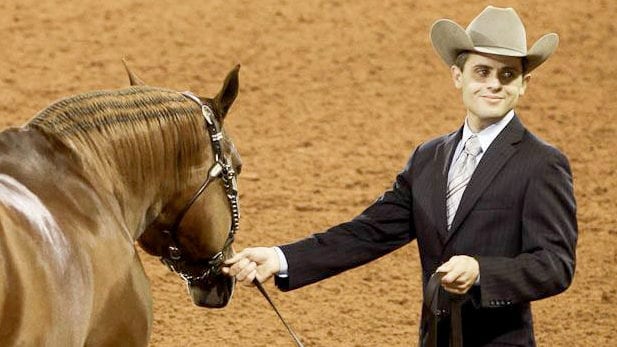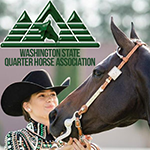Originally published 2017
For those of you who grew up in 4-H showing livestock and showmanship, the inspection is probably the most essential part of the class. With horses, watching winning exhibitors present their horse for inspection is like viewing a well-choreographed dance routine. When practiced and perfected, the motions are fluid and enjoyable to watch.
Over the years, styles have changed. Some may remember every exhibitor lining up, performing the pattern, and returning to the line for inspection as the judges weaved in and out. Today, natural is the style. We spoke with AQHA Judge, Brad Kearns, to get the latest information on perfecting the inspection.
A Silent Interview
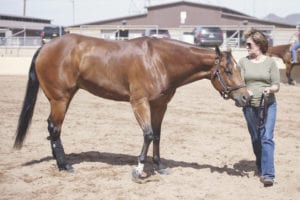 Imagine the inspection in showmanship is like a silent business interview where the exhibitor presents his or her product (the horse) to a potential proprietor (the judge). Crossovers are crucial to communicating confidence and expertise.
Imagine the inspection in showmanship is like a silent business interview where the exhibitor presents his or her product (the horse) to a potential proprietor (the judge). Crossovers are crucial to communicating confidence and expertise.
Kearns explains, “The crossovers in the showmanship are judged with a few criteria in mind. Correctness is the most important and should be the easiest to gain points. Practice, practice, practice – either with your trainer, parent, friend, or imaginary judge doing the walk around. Think of the horse as a clock for the crossovers. If the exhibitor is on the near (left) side, then, they should be at 10 o’clock. Then, as they move comparable to the judge’s position, they will move to 2 o’clock on the far side.”
Kearns adds, “Quality is the second criteria and will improve with practice. The more a person practices, the more confident they will become, this, in turn, will gain them points in smoothness, finesse, and confidence.”
Carrying Confidence
Kearns, who has hauled three youths to high point national titles as well as coached multiple AQHA World and Congress Champions, likes to see what he calls ‘quiet confidence.’ He describes, “The ability of the exhibitor to effortlessly present their horse to the judge without other distracting movements. The more natural the exhibitor can be, the smoother their movements appear. The exhibitor should make the judge feel that their horse is the best horse in the class regardless of size, conformation, etc. Authenticity is key here; judges see right through fake motions.”
Practice Makes Perfect
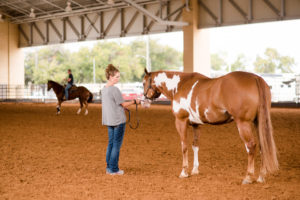 Novices and beginners should plan on doing their homework before hitting the show ring. This may include reading articles, practicing at home without a horse (around a table or with a friend), and, of course, in the barn.
Novices and beginners should plan on doing their homework before hitting the show ring. This may include reading articles, practicing at home without a horse (around a table or with a friend), and, of course, in the barn.
Growing up in 4-H and AQHYA, Kearns was once a beginner too. Now, as an accomplished judge and coach, he suggests, “Beginners should always focus on being correct. Knowing the quarter system is paramount. A beginner should make themselves comfortable with the system by practice, practice, practice. The more comfortable a person is using this method, the more it will become second nature, and they won’t even have to think about if they are in the right position.”
Kearns suggests the following exercise for practice. “An integral part of the inspection is the setup. Perfecting the setup comes from practicing the setup repeatedly so that it becomes second nature to the exhibitor and the horse. Horses, like people, learn from repetition. If a person wants to become proficient at the setup, then try these simple exercises: A) walk ten steps and stop and setup, practice crossing over and back a few times, repeat. Do about two laps each direction of your arena. B) Trot 10 steps stop and setup, practice crossing over and back, repeat. Do about two laps each direction of your arena.”
Stay up to Date
 Trends come and go, and the inspection stage of showmanship is no exception. Judges penalize out of date techniques such as over showing and fake, mechanical maneuvers, especially during crossovers.
Trends come and go, and the inspection stage of showmanship is no exception. Judges penalize out of date techniques such as over showing and fake, mechanical maneuvers, especially during crossovers.
Kearns clarifies, “For me, using the foot closest to the horse to begin the crossover is outdated. It is what I did as a youth, and some still do it today. As a judge, I don’t deduct someone’s score if they perform the crossovers this way; it is just not a natural movement. I prefer to teach students to begin their crossover with their foot that is further from the horse.
For example, a person standing on the near side (horse’s left) would have their right foot closest to the horse and left foot furthest from the horse. Starting the crossover with the right foot means the person would have to rotate their body almost 180 degrees, swinging their right foot around and spinning on their left foot to start around the horse’s head. Then, they would take a step with the left foot and then bring the right foot beside the left to close their feet. It is awkward and unnatural. A person would not get up from behind their dinner table and start to step away from the table with the first step being a twist of the hip into the table with the leg opposite of the direction they want to go.”
Kearns concludes, “So for me, it is much more natural if you start with the leg of the direction you want to travel. Again, the exhibitor is on the near side of the horse and wants to crossover to the far side. Starting with the left foot, step 1 slightly left and up around the head, step 2 with right foot continuing around the head, step 3 left foot lands in the proper show position spot and then step 4 is closing the right foot to the left foot for the presentation of the horse.”
Forfeit the Fake
 As a judge, Kearns also cannot stress enough for exhibitors to keep it natural, “Fake should be saved for eyelashes and knock-off handbags. Unnatural, excess movements are not necessary. Smooth, natural movements that come from hours and hours of practice are ideal.”
As a judge, Kearns also cannot stress enough for exhibitors to keep it natural, “Fake should be saved for eyelashes and knock-off handbags. Unnatural, excess movements are not necessary. Smooth, natural movements that come from hours and hours of practice are ideal.”
And counterfeit, fabricated movements are also many judges pet peeves. “Over showing is something unnatural. Some may do the ‘Jack in the box’ – crossing over by squatting down and quickly stepping to the other side of the horse’s head and popping up by straightening their legs rapidly, jerking their back straight up, and snapping their head up and back. This is done so quickly it appears that the ‘pop goes the weasel’ song just ended, and the clown has popped out of the jack in the box.”
Rather, Kearns says, “The crossovers should be more like a waltz: smooth, rhythmic, and effortless without excess motion. Some exhibitors overshow by getting too much arch to the back, head too far back with the brim of the hat too high, and overdo their posture.”
Kearns also sees a lot of people overshow by being super speedy. “The showmanship is not a timed event. Turning so fast that the exhibitor appears to be running to keep up with the horse is not acceptable nor pleasant to watch. Trying to back so fast that the horse balls up in a knot with its head touching its chest would not be appealing in a riding performance, so it would not be appealing in a showmanship class.”
Snag your Swagger
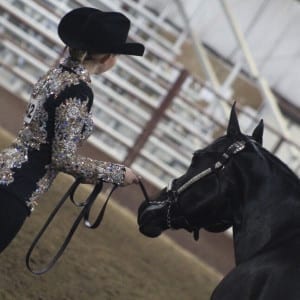 In keeping it natural, it is also imperative that exhibitors have fun in creating their style if they wish to make a statement in showmanship.
In keeping it natural, it is also imperative that exhibitors have fun in creating their style if they wish to make a statement in showmanship.
“Personal style is as it says, personal. All people develop their personalities over the years from incorporating things they admire from other individuals and tweaking them to fit themselves. Watch the people who win – the people who you think look like they are on track to be winners and pick up things they do and try them. Watch Beyoncé and bring a little of the bounce in her step to your walk. Bruce Springsteen has a quiet swagger about him – find your swagger. And again, practice so your swag is natural.”


